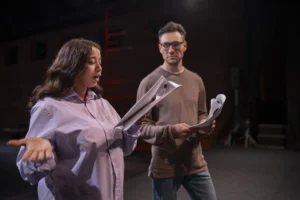How the backstage of a blockbuster production works. The magic of a Hollywood blockbuster starts long before the cameras roll. While actors may dominate the headlines, it’s the backstage crew—set designers, gaffers, camera assistants, costume stylists, and production assistants—who bring these multi-million-dollar films to life. And yes, they’re hiring.
Major productions are filmed in high-activity states like California, Georgia, New York, and New Mexico, thanks to local tax incentives and world-class infrastructure. Whether you’re aiming for a unionized job or looking to break in through freelance gigs, there’s a clear path to getting your first call sheet.
💼 Where to Find Active Film Crew Listings
- EntertainmentCareers.net – Filters by department (production, lighting, wardrobe, etc.)
- Staff Me Up – Popular for freelance crew roles in film and TV
- ProductionHUB – Nationwide listings for crew, vendors, and creative collaborators
Most jobs are posted shortly before filming begins, so checking frequently is essential.
Backstage Jobs That Are Always in Demand
No matter the genre, location, or budget, blockbuster films need a reliable technical and creative crew. These are roles consistently hiring across productions:
Top Crew Positions and What They Pay
- Production Assistant (PA): Entry-level support role, averaging $700–$1,200/week
- Gaffer (Chief Lighting Technician): $55,000–$90,000/year depending on experience and union status
- Set Decorator or Props Specialist: $1,500–$3,000/week depending on the production
- Wardrobe Assistant: $1,200–$2,000/week, varies by department and scale of the shoot
- Camera Assistant (1st or 2nd AC): $1,400–$2,400/week, often hired through the union
How to Land a Job Behind the Scenes of a Major Film
What Hiring Managers and Coordinators Look For
Behind every blockbuster is a production office hiring dozens—sometimes hundreds—of crew members. But how do you get noticed?
Here’s what coordinators and department heads consistently value when reviewing applicants:
- Availability and flexibility — Productions move fast; being available on short notice is a major plus
- On-set experience — Even if it’s indie or student film work, showing up on time and knowing set etiquette stands out
- Strong referrals — A good word from someone on the crew is often more valuable than a polished résumé
- Clear skillsets — Whether you specialize in lighting, costumes, or logistics, your abilities need to be immediately obvious
Even in entry-level roles, your resume should reflect the language of set life, like “lock-ups,” “call sheets,” “wrangling gear,” and “coordinating talent schedules.”
Certifications That Help You Get Hired Faster
While you don’t need a college degree to work in most crew jobs, certain safety and compliance certifications are often required before stepping onto a professional set.
Some of the most recognized credentials include:
- OSHA 10 or 30 Certification – Especially useful for working around rigging, stunts, and construction
- COVID Compliance Officer (CCO) Training – Still relevant on some union or international productions
- CPR/First Aid Certification – Preferred for production assistants, grips, and location crews
- Aerial Lift / Forklift Certifications – Highly sought-after in set construction and lighting departments
You can find these certifications through platforms like Set Safety or IATSE Training Trust Fund.
Should You Go to Film School?
It depends on your goals. If you want to work as a director or cinematographer in the long run, a strong film program can provide valuable mentorship, resources, and networking. However, many crew jobs don’t require degrees at all.
In fact, most PAs, grips, and lighting techs build their reputation by being reliable, fast learners on set, not by showing credentials. Real-world experience often outweighs formal education.
Production Assistant (PA) — The Best First Step
If you’re trying to break into the world of big-budget filmmaking, becoming a Production Assistant is often the most effective path. PAs handle everything from setting up craft services to locking down streets during a shoot. It’s a demanding but respected role that teaches you the pace, pressure, and structure of a professional film set.
Average PA pay on studio or union productions can range from $800 to $1,200 per week, depending on location and length of shoot. In cities like Atlanta or Los Angeles, experienced PAs can secure back-to-back projects and eventually move into coordinator or department-specific roles.
Other Common Entry-Level Jobs in Film Production
- Office PA: Works inside the production office handling paperwork, calls, and vendor coordination
- Set PA: Based on location and works directly with assistant directors to support day-to-day filming
- Art Department Assistant: Helps organize props, paint sets, or manage logistics in scenic design
- Locations PA: Supports the locations team with permits, signage, and managing the flow of crew and gear
- Script Coordinator Assistant: Great for those who want to work near writers and the director
How to Build Connections That Lead to Long-Term Work
Networking Tactics That Actually Work
In blockbuster productions, many jobs are never advertised. They’re offered via word of mouth or directly to people already in the network. Here’s how to create your own in:
- Volunteer on small sets or student films — You’ll meet people who will eventually move up and remember your work
- Join professional organizations — Like Women in Film, IATSE locals, or National Association of Latino Independent Producers (NALIP)
- Attend call sheet wrap parties, mixers, and local screenings — People hire who they know, especially on short timelines
- Stay in touch after a project — A simple “thank you” email or checking in between productions keeps your name in rotation
Standing Out From the Crowd — How to Get Picked First
What Makes Someone “Rehire Material”
Production managers keep mental (and often physical) lists of crew members they’d work with again. To make that list, you need to stand out for the right reasons:
- Be early, not just on time — The crew sets the energy before sunrise. Show up 15–30 minutes ahead of call time.
- Stay calm under pressure — On set, things constantly change. Crew members who adapt quickly and keep their cool are invaluable.
- Respect the chain of command — Speak when spoken to, stay focused, and understand the roles of each department.
- Ask smart questions off the clock — Be curious, but never interrupt during a shoot. Save learning moments for lunch or wrap.
Consistency matters more than brilliance. If you’re dependable and professional, you’ll be hired again—and recommended.
Climbing the Ladder on a Blockbuster Set
Some crew members stay in the same role for years; others climb fast. It depends on your department, work ethic, and ability to network. Here’s a general idea of how progression works:
- 1–2 years as a PA or assistant
- 2–4 years into coordinator or technician roles (depending on the department)
- 5+ years into leadership roles like key grip, gaffer, or production supervisor
Union membership can accelerate career growth, especially in departments like camera, lighting, and sound. Once you’re in, you get access to higher-paying projects, benefits, and better job security.
From Film Fan to Paid Crew Member
Working behind the scenes of a blockbuster isn’t reserved for the elite or highly connected. If you’re willing to start small, take feedback, and grind on long days, you can absolutely build a career on set. There are thousands of people making a living in this world—and there’s room for you, too.
The real magic isn’t just what happens on camera. It’s what happens in the early call times, late wrap-ups, and the focused hands of the crew. If you want to be part of it, the doors are open—but you have to show up ready.



